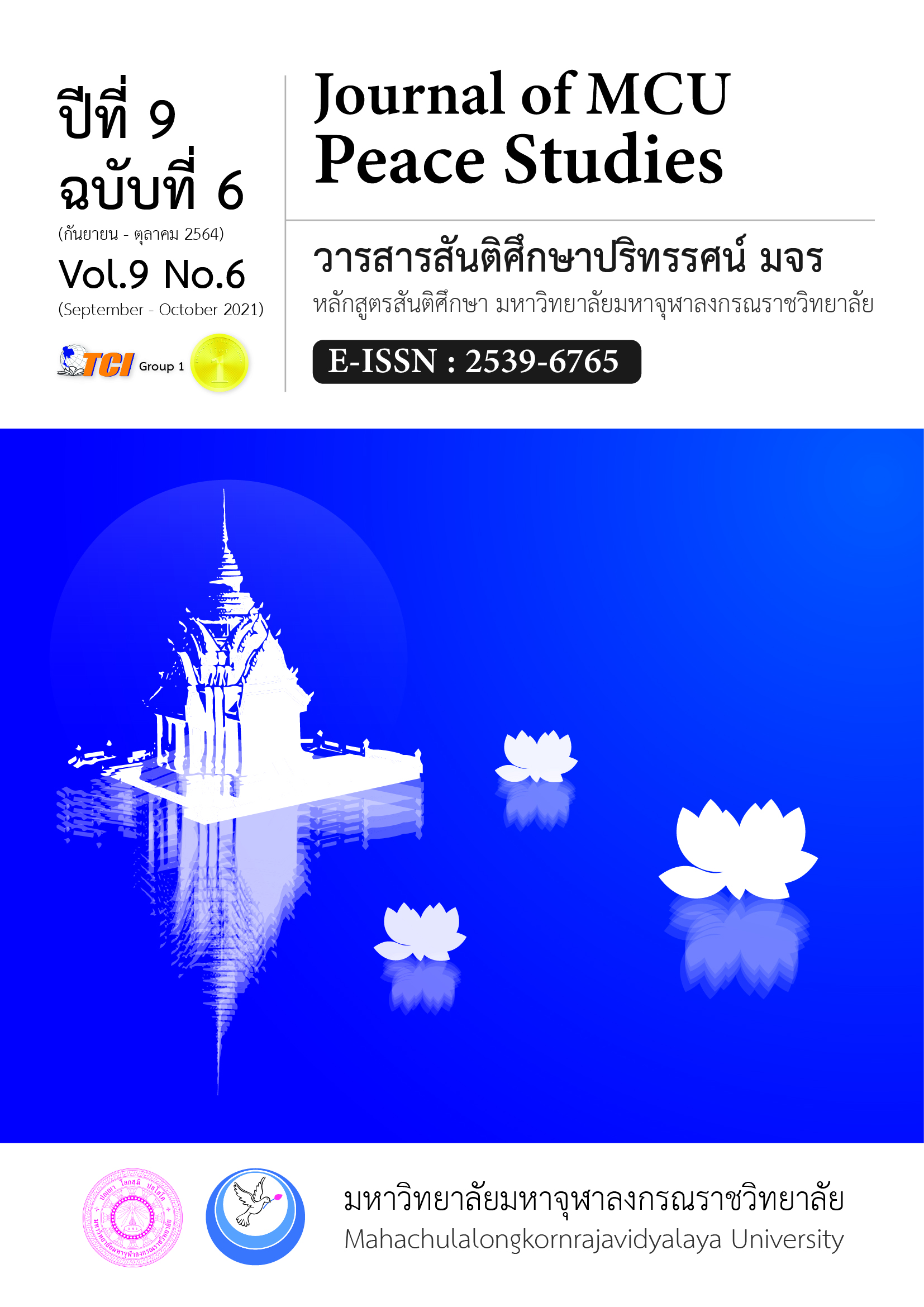คุณลักษณะการท่องเที่ยวเชิงสร้างสรรค์ที่นักท่องเที่ยวคาดหวัง ในแหล่งจุดหมายปลายทางเชิงสร้างสรรค์ในประเทศไทย
Main Article Content
บทคัดย่อ
บทความวิจัยนี้มีวัตถุประสงค์เพื่อพัฒนาองค์ประกอบคุณค่าคุณลักษณะของการท่องเที่ยวเชิงสร้างสรรค์ที่คาดหวังจากมุมมองของนักท่องเที่ยวเชิงสร้างสรรค์ในครั้งนี้ ผู้วิจัยได้ออกแบบการวิจัยเป็นการวิจัยเชิงปริมาณ โดยการเก็บข้อมูลจากนักท่องเที่ยวที่เดินทางมาท่องเที่ยวในเมืองสร้างสรรค์ระดับโลกของประเทศไทยใน 4 พื้นที่ ได้แก่ จังหวัดภูเก็ต เชียงใหม่ กรุงเทพมหานคร และสุโขทัย จำนวน 400 ชุด ใช้เทคนิคการสุ่มตัวอย่างแบบโควต้า และการสุ่มตัวอย่างแบบบังเอิญ วิเคราะห์ข้อมูลโดยการหาร้อยละ ค่าเฉลี่ย ส่วนเบี่ยงเบนมาตรฐาน และการแจกแจงความถี่ เพื่อคัดกรองเฉพาะนักท่องเที่ยวเชิงสร้างสรรค์ พบว่า นักท่องเที่ยวผู้ตอบแบบสอบถามมีค่าเฉลี่ยความปรารถนาต่อประสบการณ์สร้างสรรค์อยู่ในระดับปานกลาง – ระดับสูง จำนวนร้อย 100 แสดงว่านักท่องเที่ยวทั้งหมดเป็นนักท่องเที่ยวเชิงสร้างสรรค์ จากนั้นวิเคราะห์ข้อมูลความคาดหวังคุณค่าคุณลักษณะของการท่องเที่ยวเชิงสร้างสรรค์จากมุมมองของนักท่องเที่ยวเชิงสร้างสรรค์ในประเทศไทย โดยการวิเคราะห์ปัจจัยเชิงสำรวจ จากชุดตัวแปร 17 รายการ ผลการทดสอบค่า KMO = 0.910 ค่า Bartlett's Test of Sphericity มีความสัมพันธ์กันอย่างมีนัยสำคัญทางสถิติที่ระดับ 0.00 ผลการวิจัยพบว่า คุณลักษณะการท่องเที่ยวเชิงสร้างสรรค์ที่นักท่องเที่ยวคาดหวังจากมุมมองของนักท่องเที่ยวเชิงสร้างสรรค์ สามารถจำแนกได้ 4 องค์ประกอบ ได้แก่ องค์ประกอบที่ 1 พื้นที่และสิ่งแวดล้อมเชิงสร้างสรรค์ (Eigen Value = 7.330) องค์ประกอบที่ 2 การมีส่วนร่วมเชิงสร้างสรรค์ (Eigen Value = 1.483) องค์ประกอบที่ 3 ความมีเสน่ห์ ความหายาก และความแปลกใหม่เชิงสร้างสรรค์ (Eigen Value = 1.180) และ องค์ประกอบที่ 4 คุณค่าพื้นฐานตามหน้าที่เชิงสร้างสรรค์ (Eigen Value = 1.037)
Article Details
ทัศนะและความคิดเห็นที่ปรากฏในบทความในวารสาร ถือเป็นความรับผิดชอบของผู้เขียนบทความนั้น และไม่ถือเป็นทัศนะและความรับผิดชอบของกองบรรณาธิการ ยินยอมว่าบทความเป็นลิขสิทธิ์ของวารสาร
เอกสารอ้างอิง
Caber, M., Albayrak, T., & Matzler, K. (2012). Classification of the destination attributes in the content of competitiveness (by revised importance-performance analysis). Journal of Vacation Marketing, 18(1), 43-56.
Charoenkittayawut, S. (2015). A Structural Equation Model of Destination Loyalty among European Tourists Visiting Phuket Province, Thailand. (Master’s Thesis). Business Administration, Prince of Songkla University. Songkla.
Chang LL., Backman, K. F., & Huang, Y. C. (2014). Creative tourism: a preliminary examination of creative tourist’s motivation, experience, perceived value and revisit intention. International journal of culture, tourism and hospitality research, 8(4), 401-419.
Chugh, S., R. (2018). Creative Tourism: An Endogenous Approach to Developing Culturally and Environmentally Sustainable Tourism. International Journal of Hospitality & Tourism Systems, 11(1), 60-66.
Chumduang, W. (2018). Integrating Creative Tourism Strategy with Cultural Heritage Attraction Through Participatory Process: A Case Study of the History City of Sukhothai Community. Journal of Industrial Education, 17(3), 30–39.
Dhamabutra, P. (2019). Approaches for Sustainable Integrated Creative Tourism Development on the Basis of Thai Identity and Way of Life in Bangkoknoi District, Bangkok Thailand. Sisaket Rajabhat University Journal, 13(3), 65–75.
Hair, J. F., Black, W. C., Babin, B. J., & Anderson, R. E. (2010). Multivariate data analysis: Global edition. In: Pearson Higher Education Upper Saddle River, NJ.
Kiatkawsin, K., & Han, H. (2017). An alternative interpretation of attitude and extension of the value–attitude–behavior hierarchy: the destination attributes of Chiang Mai, Thailand. Asia Pacific Journal of Tourism Research, 22(5), 481–500.
Kim, J.-H. (2014). The antecedents of memorable tourism experiences: The development of a scale to measure the destination attributes associated with memorable experiences. Tourism Management, 44, 34–45.
Mahdzar, M., Shuib, A., Ramachandran, S., & Afandi, S. H. M. (2015). The role of destination attributes and memorable tourism experience in understanding tourist revisit intentions. American-Eurasian Journal of Agriculture & Environmental Science, 15(1), 32-39.
National Tourism Policy Board. (2017). The National Tourism Development Plan No. 2 (2017 – 2021). Ministry of Tourism & Sports: Bangkok.
OECD. (2014). Tourism and the Creative Economy, OECD Studies on Tourism, OECD Publishing. Retrieved January 17, 2020, from http://dx.doi.org/10.1787/9789264207875-en.
Ohridska-olson, R., & Ivanov, S. (2010). Creative Tourism Business Model and its Application in Bulgaria. Proceedings of the Black Sea Tourism Forum 'Cultural Tourism – The Future of Bulgaria,' 2010. n.p.
Phakdee-auksorn, P., & Pattaro, P. (2019). Maslow’s Hierarchical Need Theory and International Tourist’s Motivation for Food as a Tourist Attraction in Phuket. Journal of International Studies, 9(1), 1–28.
Punpukdee, A. (2016). The Comparison of the Use of Statistics Analysis in Testing Construct Validity of Social Capital: An Exploratory Factor Analysis (EFA) and A Confirmatory Factor Analysis (CFA). BEC Journal of Naresuan University, 11(2), 46-61.
Raymond, C. (2010). The Practical Challenges of Developing Creative Tourism. In Wurzburger, R., Aageson, T., Pattakos, A., & Pratt, S. (Eds.). A global conversation. How to provide unique creative experiences for travelers worldwide (pp.63-69). Santa Fe: Sunstone Press.
Richards, G. (2010). Creative Tourism and Local Development. In Wurzburger, R., Aageson, T., Pattakos, A., & Pratt, S. (Eds.). A global conversation. How to provide unique creative experiences for travelers worldwide (pp.78-90). Santa Fe: Sunstone Press.
Richard, G. (2011). Creativity and Tourism The State of Art. Annals of Tourism Research, 38(4), 1225–1253.
Richards, G., & Raymond, C. (2000). Creative tourism. ATLAS news, 1(23), 16-20.
Roscoe, J. T. (1969). Fundamental research statistics for the behavioral sciences. New York etc.: Holt, Rinehart and Winston.
Sudasna Na Ayudhaya, B. et al. (2018). Development of Handicrafts to Promote Tawai Village Community - Based Tourism. Thamasat Journal, 37(1), 125-148.
Tan, S., Kung, S., & Luh, D. (2013). A Model Of ‘Creative Experience’ In Creative Tourism. Annals of Tourism Research, 41, 153-174.
UNESCO. (2015). Phuket Gastronomy, Creative City. Retrieved December 10, 2019, from https://en.unesco.org/creative-cities//node/374.
UNESCO. (2017). Chiang Mai Craft and Folk Arts, Creative City. Retrieved December 10, 2019, from https://en.unesco.org/creative-cities//node/965.
UNESCO. (2019). Bangkok City of Design, Creative City. Retrieved March 18, 2020, from https://en.unesco.org/creative-cities/bangkok.
UNESCO. (2019). Sukhothai Craft and Folk Arts, Creative City. Retrieved March 18, 2020, from https://en.unesco.org/creative-cities/sukhothai.
Wisudthiluck, S., & et. al. (2011). The Role Model of Thailand Creative Tourism. Funded by Designated Areas for Sustainable Tourism Administration (Public Organization). n.p.
Wurzburger, R. (2010). Introduction to The Santa Fe & UNESCO International Conference a Global Conversation on Best Practice and New Opportunities. Santa Fe: Sunstone Press.


